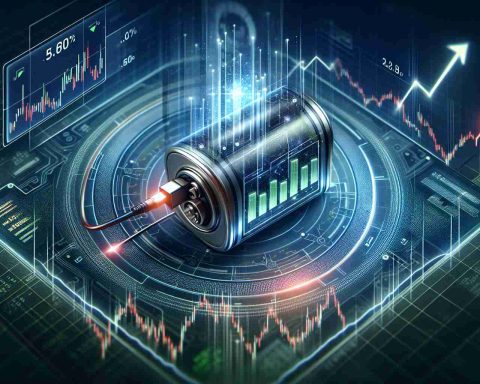Pioneering the Future of Electric Mobility
A transformative wave is set to sweep across the transportation sector as solid-state batteries prepare to redefine the electric vehicle (EV) market. This cutting-edge technology, which has long tantalized researchers, will soon transition from the lab to the road, signaling a new era in energy solutions.
Core Advantages Redefined:
Solid-state batteries bring a leap forward in energy density, safety, and charging efficiency, offering compelling benefits over traditional lithium-ion batteries. The increased energy density means EVs can achieve longer distances on a single charge, addressing one of the biggest drawbacks of conventional electric vehicles. Safety is enhanced as the potential for battery fires is minimized without liquid electrolytes, adding a layer of security for EV users.
Expect to see shortened charging times, making electric vehicles a more practical choice for everyday users who value convenience.
Industry Front-Runners:
Leading companies like Toyota and QuantumScape are at the forefront, pushing forward the commercialization of this revolutionary technology, with promising timelines suggesting market availability in the coming years.
# The Road Ahead
The integration of solid-state batteries promises a major leap in the EV market, potentially accelerating the adoption rate and leading to unprecedented growth by 2030. This surge is being driven by consumer demand alongside substantial governmental investment in fast-charging infrastructures and eco-friendly policies that are aligned with global climate goals.
The Bigger Picture:
As adoption becomes widespread, these batteries are set to power diverse vehicle types, from everyday commuter cars to high-end luxury models, heralding a green future.
Keep your eye on this dynamic evolution in the world of transportation, as solid-state batteries shimmer on the horizon, promising not just a reduction in carbon emissions but also a smarter, sustainable future for travel enthusiasts worldwide.
The Dawn of Solid-State Batteries: A Green Catalyst for Change
The transition to solid-state batteries represents a significant advancement that influences not just the electric vehicle (EV) market but also extends its ramifications to the environment, humanity, the economy, and potentially the future course of global affairs.
Environmental Impact:
The environmental implications of transitioning to solid-state batteries are profound. Unlike traditional lithium-ion batteries, solid-state variants significantly reduce the risk of leakage and potential chemical spills, owing to the absence of liquid electrolytes. This factor alone considerably mitigates the risk of environmental contamination. More importantly, the push towards solid-state technology inevitably leads to a reduction in fossil fuel dependency, as more efficient and longer-range electric vehicles render gas-guzzling counterparts obsolete.
Furthermore, the enhanced efficiency and the subsequent increase in EV adoption would contribute to a marked decrease in greenhouse gas emissions. As vehicles worldwide become powered by these more sustainable batteries, the cumulative effect could be transformative in combating climate change, positively affecting global ecosystems.
Impact on Humanity:
The shift to solid-state batteries is poised to reshape human transportation lifestyles fundamentally. With improved safety features minimizing the risk of battery fires—one of the critical concerns deterring potential users—these batteries promise peace of mind for consumers. Reduced charging times and longer distances achievable on a single charge mean that EVs become not only viable but preferable over traditional vehicles. This change is expected to democratize access to electric vehicles, thereby crafting a human story of inclusivity in mobility where green solutions are accessible to the masses.
Economic Implications:
Economically, the widespread adoption of solid-state batteries is set to invigorate the EV market, fostering new opportunities for growth and innovation. Leading industries such as Toyota and QuantumScape are spearheading this change, backed by substantial investments. Sectors surrounding battery production, EV manufacturing, and charging infrastructure are likely to experience significant job creation, driving economic growth in new directions.
Moreover, as governments worldwide invest in these technologies through incentives and eco-friendly policies, there’s potential for a robust global economy centered around sustainable technologies. The associated reduction in healthcare costs, thanks to fewer pollutants in the air, also contributes to a healthier, more economical future.
Future Connections:
On a broader scale, the solid-state battery revolution could serve as a prototype for how to integrate advanced, sustainable technologies into everyday life. The technological leap represents not just an evolution in how we travel, but a pivotal shift in our approach to global energy consumption. By setting an example in the automotive industry, other sectors may follow suit, embracing innovative solutions that prioritize the planet.
As this technology achieves full integration, solid-state batteries may well become an emblem of progress in the 21st century—a glimpse into a future where human advancement goes hand in hand with environmental stewardship. Through this lens, humanity can envision sustainable development that truly benefits the global community, steering civilization towards a more resilient and equitable future.
How Solid-State Batteries Could Revolutionize the Future of Electric Vehicles
Emerging Trends and Market Insights
As solid-state batteries transition from science fiction to tangible innovation, they are poised to revolutionize the electric vehicle (EV) industry. With significant advancements in technology, these batteries are not only seen as an upgrade but a breakthrough that can change the dynamics of energy consumption and efficiency in transportation.
Key Specifications and Features
Solid-state batteries offer an astounding increase in energy density, allowing electric vehicles to travel significantly longer distances on a single charge compared to traditional lithium-ion batteries. One of the standout features of these batteries is their enhanced safety profile. By removing liquid electrolytes, the risk of battery fires is significantly reduced, raising the safety standards for EV operations.
Another exciting advancement is in charging times. Solid-state batteries promise to reduce the time spent at charging stations, offering unparalleled convenience for EV users who have tight schedules or long commutes.
Pros and Cons of Solid-State Batteries
# Pros:
– Higher Energy Density: Supports longer travel ranges.
– Improved Safety: Minimizes risks of fire.
– Faster Charging Times: Increases practicality for everyday use.
# Cons:
– Production Costs: Currently higher than traditional batteries.
– Infrastructure Needs: Requires new production and recycling infrastructure.
– Initial Limited Supply: Early adoption might face scalability issues.
Innovations and Industry Leaders
Companies like Toyota and QuantumScape are leading the charge in bringing solid-state batteries to market. Their efforts promise to make these advanced batteries commercially available within a few years, aligning with automotive giants’ vision of a more sustainable industry.
Market Analysis and Predictions
Recent market analyses predict an accelerated growth in the EV sector as solid-state batteries begin to roll out. With increased consumer demand, government investments, and eco-friendly policies, solid-state batteries are set to become a cornerstone in the transition to a green economy. This shift aligns with projections of a significant market expansion by 2030, driven by both technology and environmental initiatives.
Security and Sustainability
The adoption of solid-state batteries represents a leap towards sustainability, reducing carbon footprints and aligning with global climate targets. The robustness and safety features of these batteries also address security concerns, providing consumers with greater assurance in adopting EV technology.
Conclusion
In summary, the emergence of solid-state batteries is a game-changer in the electric mobility landscape. Their innovative features and promising market potential make them a central focus for the future of transportation. As this technology continues to develop, it holds the promise of not just enhancing the efficiency and safety of electric vehicles but also contributing significantly to a sustainable future. Keep watch as this technology unfolds; it signifies a pivotal moment for energy solutions worldwide.












